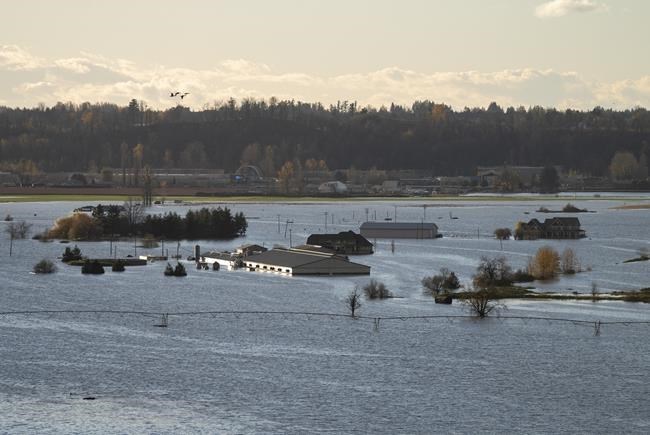The federal government promised to expedite employment insurance applications and ease travel restrictions at British Columbia's borders on Sunday, among a host of measures meant to help residents of the flood-ravaged province recover from recent storms and weather new ones expected in the days ahead.
The show of support from Ottawa came as Environment Canada redoubled its warnings about more wet weather set to sweep through a province that's already registered record rainfalls in the past week, which triggered mudslides that have killed four people to date and crippled much of B.C.'s economic and agricultural activity.
Speaking at a news conference alongside several of her cabinet colleagues, Employment Minister Carla Qualtrough said British Columbians displaced or left jobless due to extreme flooding should immediately apply for employment insurance benefits -- even if they wouldn't normally be eligible.
She said the federal government would waive the requirement for applicants to show a record of employment, recognizing that it may be difficult for many to obtain the proper documentation under current circumstances.
"Obviously it could be very difficult in these times to get that ... particular document," she said. "We're looking at the reality of pandemic benefits and people having exhausted their EI has impacted their availability of ongoing EI supports."
Qualtrough said people should apply anyway, adding the federal government "will figure this out" for them one way or another and Ottawa will be there to support British Columbians through this crisis.
Defence Minister Anita Anand, who also spoke at Sunday's news conference, said 500 members of the Canadian Armed Forces are on the ground or on their way to British Columbia already and thousands more are ready to go if needed.
Roughly three dozen military members are helping with sandbag efforts at a First Nation community near Hope, B.C., she said.
Meanwhile Emergency Preparedness Minister Bill Blair said residents of B.C. communities on or near the border with the United States will be allowed to travel south to purchase fuel or other needed items without undergoing a COVID-19 test to return home.
He said someone in Delta, for instance, could cross into Washington state at Point Roberts, refuel, and then return to Canada without needing a PCR test to enter the country.
The support from the federal government comes as another weather system known as an atmospheric river moves south, bringing more precipitation to areas already beleaguered by last week's floods and mudslides.
Environment Canada has issued a special weather statement for British Columbia's North Coast, warning of potential flooding and landslides due to heavy rains.
The region is being hit by a system expected to bring 100 to 150 millimetres of rain to the Prince Rupert area and 30 to 60 millimetres to Haida Gwaii by Monday.
The storm is then expected to head south towards parts of the province, such as Abbotsford, that are still grappling with washed-out roads and widespread, flood-related damage following last weekend's torrential downpours.
"Additional rainfall will definitely lead to more pooling on the roads and that would be followed only by a short break until Wednesday when another system approaches," Derek Lee, a meteorologist with Environment Canada, said in an interview.
Lee said the rain expected on Monday isn't too different from a normal winter storm, while Wednesday's weather system is slated to bring a "significant" amount of rain to parts of southern B.C.
Abbotsford Mayor Henry Braun told a Sunday media briefing that the damage to his community could have been worse if a key city pump station had failed.
"I have a whole new appreciation for just how close we came to this disaster being much, much worse. We came extremely close to losing this absolutely critical piece of infrastructure," he said.
The floodgates at the Barrowtown station had previously been kept shut due to excessive water levels, preventing water from the Sumas River from draining into the nearby Fraser River and forcing it up onto city land instead.
That floodgate, Braun said, has now fully reopened, allowing seven times more water to flow out to the Fraser than the pumping station could have cleared on its own.
The neighbouring city of Chilliwack lifted evacuation alerts for the communities of Yarrow and Majuba Hill, except in the case of nine properties.
Highway 7 has also been fully reopened to traffic in both directions, while the Fraser Valley Regional District is warning of an increase in logs and debris on the lower Fraser River, downstream of Agassiz.
This report by The Canadian Press was first published Nov. 21, 2021.
— With files from Joan Bryden in Ottawa
Nick Wells, The Canadian Press



